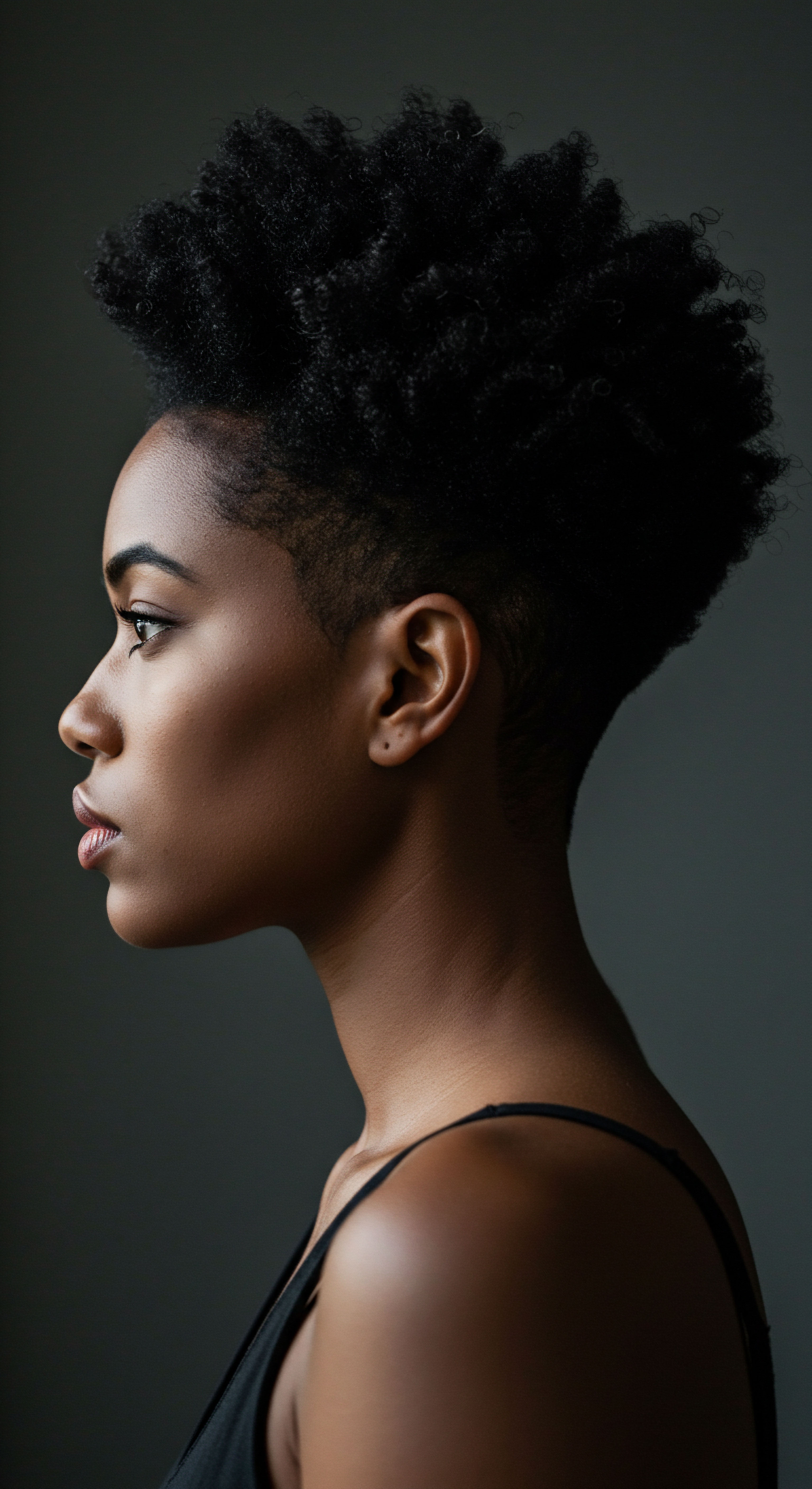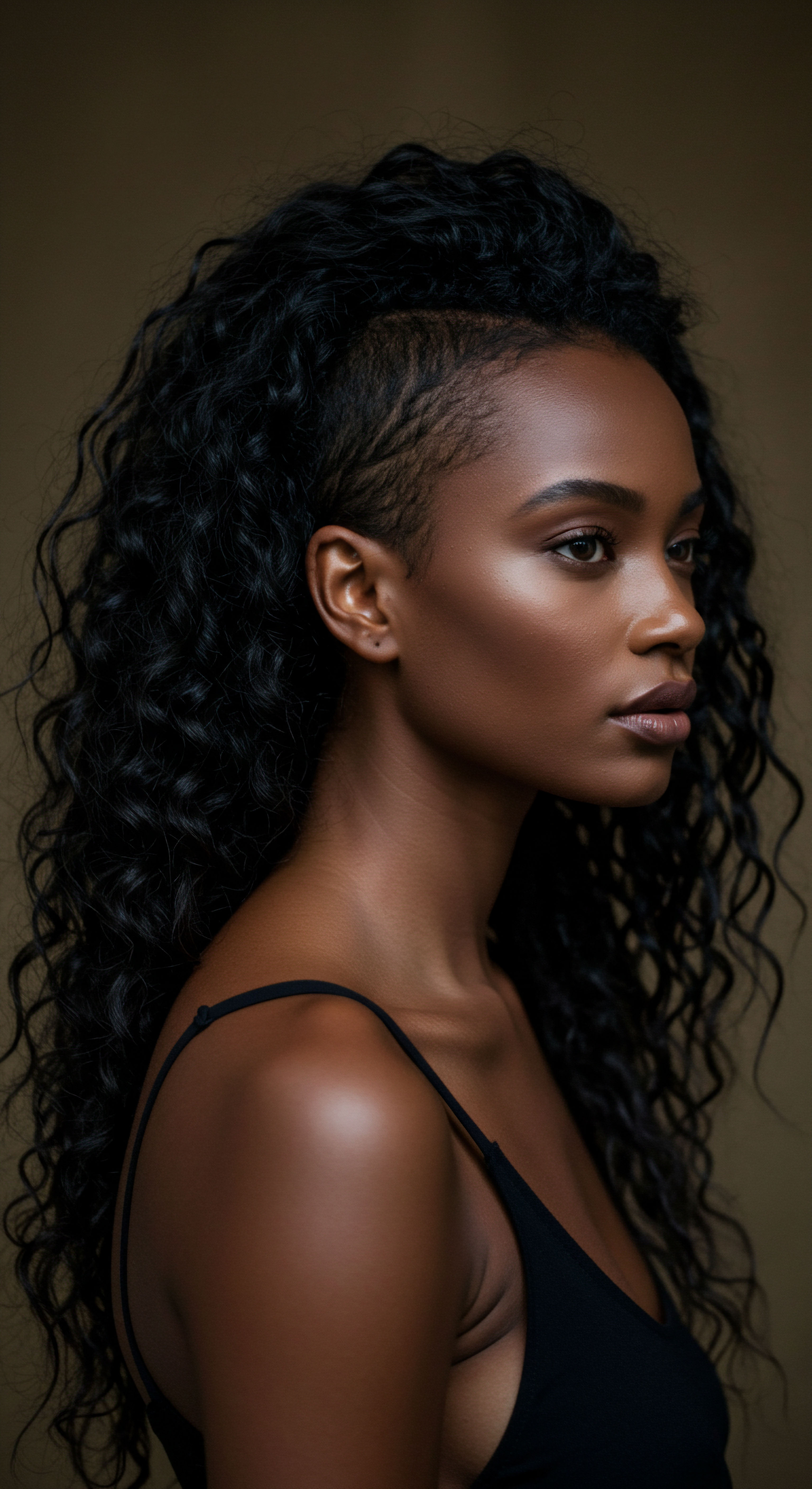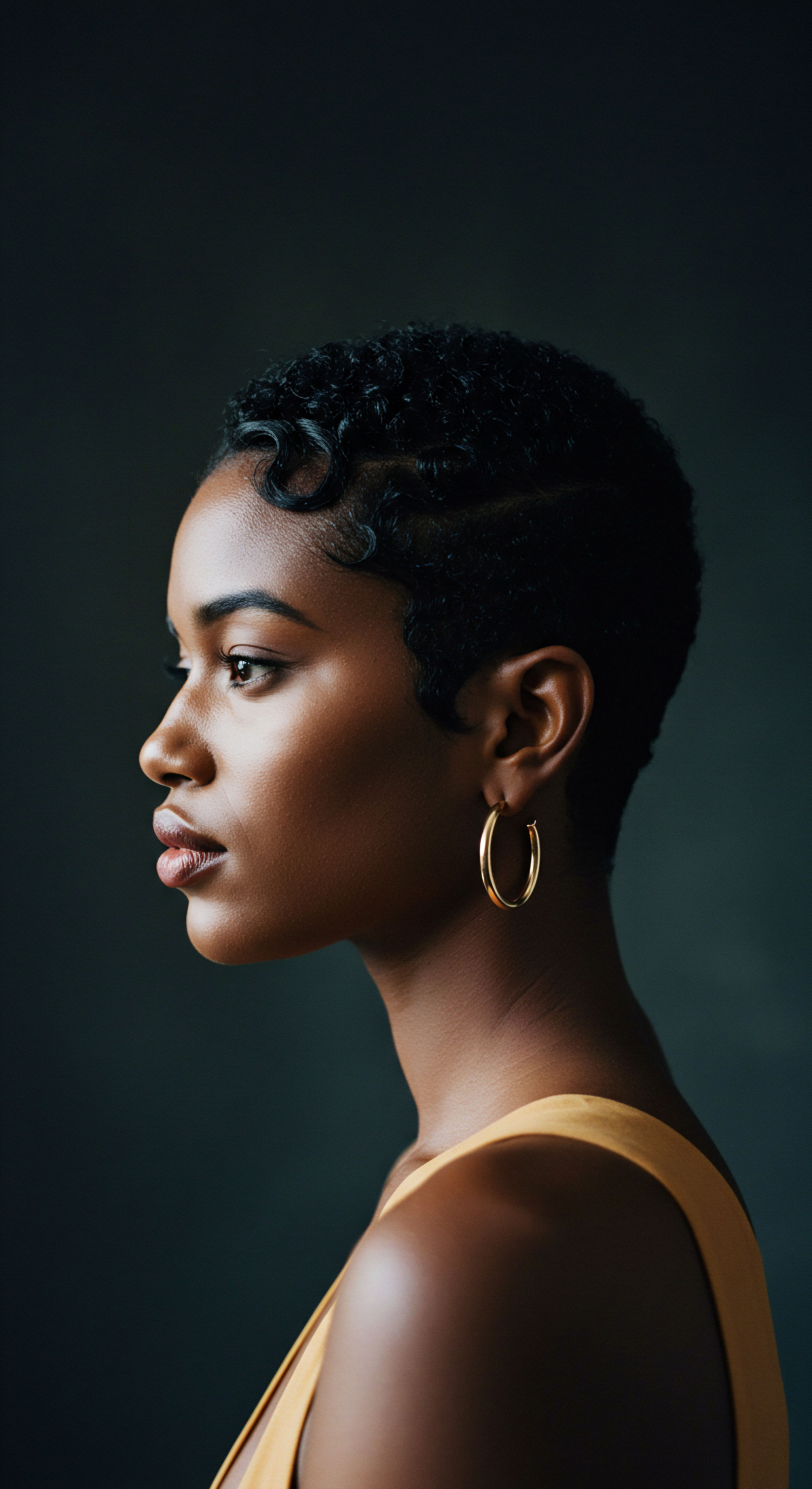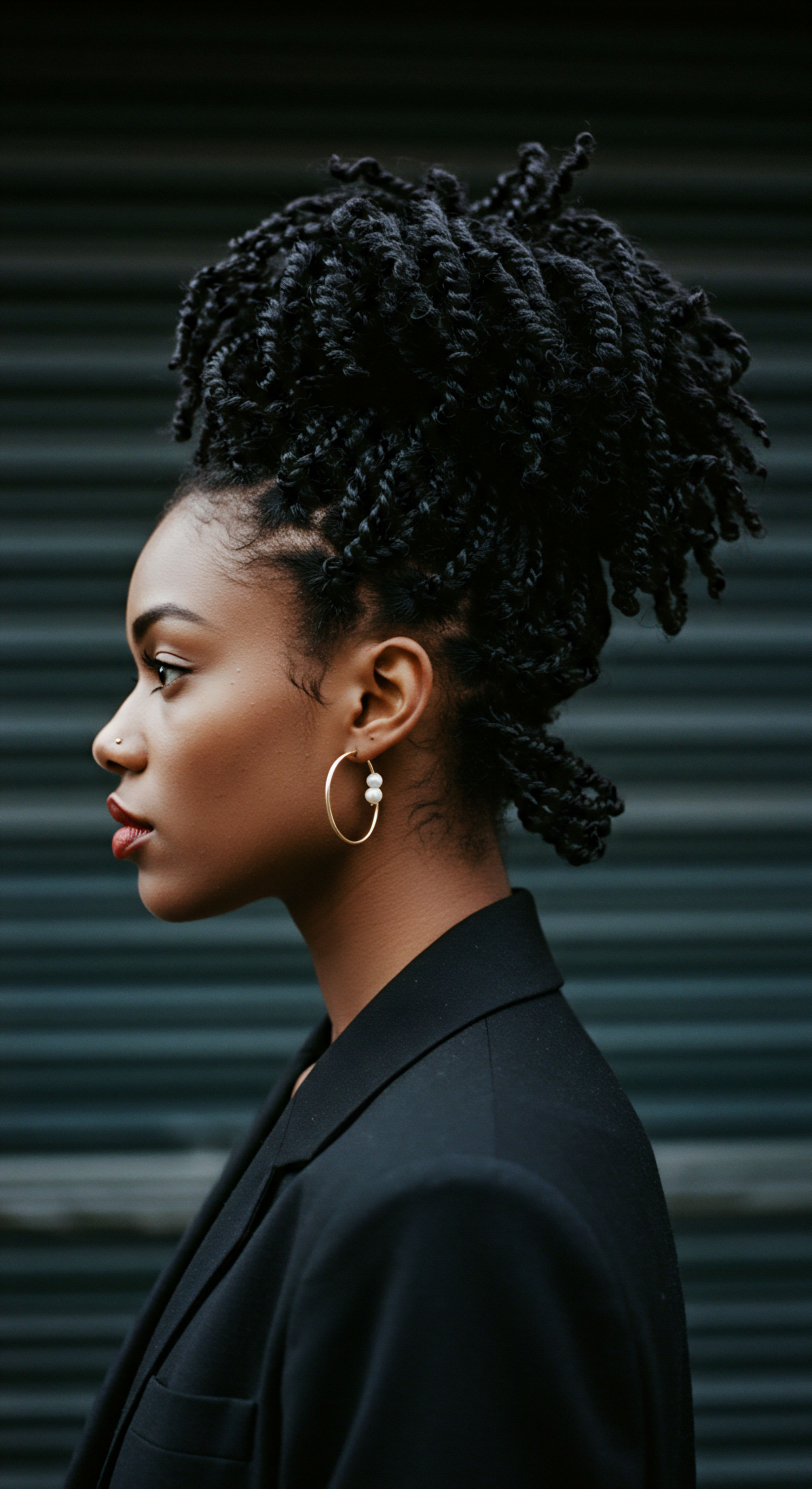
Roots
Consider for a moment the quiet strength residing within each curl, every coil, and all waves. It is a strength not merely physical, but one deeply connected to lineage, to stories carried through generations, and to an ancient wisdom that speaks of protection and preservation. This wisdom, often whispered from elder to youth, holds within its folds the foundational truths of textured hair.
We seek to understand how these ancestral practices, once common daily occurrences, might offer profound insights for our modern hair care routines. What elemental truths about hair did those who came before us instinctively grasp, truths we might now rediscover with fresh eyes and open hearts?
Hair, particularly textured hair, possesses a unique architecture, a marvel of biological design. At its core, each strand is a complex structure. The outermost layer, the Cuticle, comprises overlapping, scale-like cells, acting as a shield for the inner parts. Beneath this shield lies the Cortex, which gives hair its strength and color.
While straight hair follicles are round, those producing curly or coily hair are asymmetrical or oval-shaped, causing the hair to grow at an angle and coil as it leaves the scalp. The tighter the curl, the more oval the follicle tends to be. This structural difference means that natural oils, or sebum, produced by the scalp, find it harder to travel down the twists and turns of textured strands, often leading to greater dryness compared to straight hair.

The Inherent Resilience of Textured Strands
From a biological standpoint, textured hair, especially Afro-textured hair, displays properties that differentiate it from other hair types. It is not simply a matter of visual curl pattern. There are genetic factors at play, with variations in genes such as EDAR and KRT2 influencing hair thickness, density, and the overall protein structure. This genetic blueprint shapes the hair’s very make-up, contributing to its unique characteristics.
The hair growth cycle itself can vary between Afro-textured and European hair, influenced by both intrinsic and environmental factors. This biological distinctiveness underscores the long-held practices of ancient cultures, which intuitively catered to these specific needs.
Ancient practices hold a mirror to contemporary textured hair care, inviting us to rediscover fundamental truths about hair’s innate needs.

Understanding Curl Patterns Beyond Appearance
The classifications of textured hair, often seen in modern contexts (like Type 3 or Type 4 curls), represent an attempt to categorize the visible spectrum of curl patterns. However, ancient societies approached this not as a mere visual descriptor, but as a deep understanding of how hair behaved, how it responded to climate, and what it required for protection. For instance, the natural spiraled structure and wider follicular pattern of Afro-textured hair are believed to have adapted to provide cool air for the scalp, serving as protection from intense ultraviolet radiation in ancestral environments. This biological adaptation speaks to an ancient, inherent need for protective care, a need recognized and met through rituals.
| Hair Type Straight |
| Follicle Shape Round |
| Sebum Distribution Easy, even coating |
| Hair Type Wavy |
| Follicle Shape Slightly Oval |
| Sebum Distribution Moderate, somewhat even |
| Hair Type Curly |
| Follicle Shape Oval |
| Sebum Distribution Challenging, uneven |
| Hair Type Coily |
| Follicle Shape Highly Oval/Flat |
| Sebum Distribution Most challenging, least even |
| Hair Type Differences in follicle shape directly influence curl pattern and natural oil distribution. |

The Ancestral Whisper of Hair’s Purpose
Across ancient African societies, hair was far more than an aesthetic feature. It served as a potent symbol, communicating social status, age, marital status, religion, and tribal affiliation. Hairstyles were not just art; they were intricate maps of identity and belonging. The creation of these looks often required hours, sometimes days, making hair styling a communal ritual, a time for bonding and sharing.
This deep cultural connection meant hair was cared for with immense reverence, not just for its appearance, but for its spiritual and communal significance. This ancient reverence for hair, seeing it as a living archive of identity and resilience, offers a powerful lens through which to consider contemporary care.
Consider the ancient Egyptians, for whom wigs and elaborate hairstyles were not merely fashion statements but also markers of wealth and social standing. They even used wigs for practical purposes, such as protecting shaven scalps from the sun and for hygiene. The value placed on hair was so high that it was listed alongside precious commodities like gold and incense in ancient accounts. This historical perspective reminds us that hair care has always been deeply intertwined with protection, not just cosmetic appeal.

Ritual
As we step from the quiet understanding of hair’s inherent nature into the realm of daily practice, we seek to discover how ancient protection rituals translate into actionable wisdom for our contemporary textured hair care. Our routines, whether simple or elaborate, are a series of deliberate acts, a personal dialogue with our strands. What if these modern practices could be infused with the mindful intention and protective foresight of those who came before us? How might the historical application of care inform our current choices, moving beyond fleeting trends to enduring health?
Ancient cultures developed sophisticated systems of hair care that were inherently protective. These were not merely about adornment but about preserving the hair’s health and integrity against environmental stressors and daily wear. For instance, the widespread use of braids, twists, and other protective styles in African civilizations served multiple purposes ❉ safeguarding hair from sun and weather, reducing mechanical damage from daily manipulation, and helping to retain moisture. These methods, passed down through generations, reveal a deep understanding of how to maintain hair health in challenging climates.

The Timeless Artistry of Protective Styles
Protective hairstyles, such as braids, twists, and buns, reduce tension on the scalp and hair follicles, which helps prevent a condition called traction alopecia, where hair is pulled out from the root. By keeping hair tucked away, these styles also reduce exposure to environmental elements like wind, sun, and pollution, minimizing damage and dryness. This leads to less breakage and aids in length retention. The concept of protecting hair ends, the oldest and most fragile part of the strand, is a common thread between ancient practices and contemporary recommendations.
- Braids ❉ Ancient African societies utilized braids to signify social status, age, and tribal affiliation. Today, box braids, cornrows, and Senegalese twists remain popular protective styles.
- Twists ❉ Two-strand and flat twists offer a simple yet effective way to coil hair and reduce manipulation.
- Updos ❉ Buns and chignons, worn by various ancient cultures, provide an elegant way to secure hair, minimizing exposure.

Defining Natural Beauty with Ancestral Echoes
The pursuit of natural definition and health in textured hair is a contemporary aspiration that finds resonance in historical practices. Ancient Egyptians, for example, used henna not only as a dye but also as a protective hair treatment. Similarly, various African traditions relied on oils and butters like shea butter and castor oil to nourish the scalp and seal in moisture for textured hair. These natural ingredients provided sustenance and a protective barrier, addressing the inherent dryness often associated with coily strands.
Ancient hair care practices, particularly protective styles, were not merely cosmetic but strategic acts of preservation, reducing damage and aiding hair health.
The emphasis on moisturizing and sealing, a cornerstone of modern textured hair care, echoes these historical applications. The understanding that certain natural substances could coat and shield the hair, preventing moisture loss and environmental harm, was an intuitive scientific approach.

The Tools of Yesteryear and Today
The evolution of hair tools reflects a continuous human desire to care for and style hair. Ancient civilizations crafted simple yet effective implements from natural materials. Combs made of wood, bone, or ivory were used in ancient Egypt to maintain coiffures and keep hair tangle-free. Hairpins, often adorned, served both functional and decorative purposes.
The Greeks and Romans used bronze and iron tools, including curling irons heated over a flame to create waves and curls. While these early tools could sometimes cause damage if overheated, they laid the groundwork for modern thermal styling.
The transition from these rudimentary tools to today’s advanced implements, such as ceramic flat irons with adjustable heat settings, represents a technological leap. However, the underlying principle of manipulation and shaping remains. The safety-first approach to heat styling today, with heat protectants and temperature control, acknowledges the potential for damage that ancient users might have experienced. The historical context of tools reminds us that while materials and technology change, the fundamental acts of detangling, shaping, and protecting remain constant.
| Era Ancient Egypt |
| Common Tools Wood/Ivory Combs, Hairpins |
| Primary Purpose Maintenance, adornment, detangling |
| Era Ancient Greece/Rome |
| Common Tools Bronze/Iron Curling Rods |
| Primary Purpose Styling, wave creation |
| Era 19th Century |
| Common Tools Hot Combs, Marcel Irons |
| Primary Purpose Straightening, curling, shaping |
| Era Contemporary |
| Common Tools Ceramic Flat Irons, Satin Bonnets |
| Primary Purpose Heat styling, overnight protection |
| Era Tools have evolved, yet their function remains rooted in care and aesthetic presentation. |

Relay
How deeply do the threads of our heritage truly bind us to our hair care practices? Moving beyond the surface of historical anecdote and practical application, we arrive at a deeper consideration of the ‘Could ancient hair protection rituals offer insights for contemporary textured hair care?’. This query invites us to examine the interconnectedness of biology, psychology, and cultural heritage, revealing how ancient wisdom often aligned with principles that modern science is only now fully articulating. It is here, at this intersection, that the profound and often unspoken implications of hair care come into focus.
The cultural significance of hair, particularly for Black and mixed-race communities, extends far beyond mere aesthetics. Historically, hair has served as a powerful symbol of identity, community, and resistance. In pre-colonial Africa, hairstyles communicated social status, tribal affiliation, marital status, and even spiritual beliefs.
This deep connection meant that hair was not just a physical attribute but a communal asset, linking individuals to their ancestors and the spiritual world. This historical reverence for hair has left an enduring mark, shaping perceptions and practices today.

The Psychosocial Weight of Hair
The link between hair and identity is deeply psychological. Research indicates a strong correlation between hair and self-esteem; individuals often associate their hair with their identity and attractiveness. A study published in the Journal of Investigative Dermatology found that individuals experiencing hair loss or thinning reported lower self-esteem and reduced quality of life.
For Black communities, the pressure to conform to Eurocentric beauty standards has often led to negative self-image and anxiety regarding hair. Messages that natural hair is “unprofessional” or “messy” can lead to chronic stress and cultural disconnection.
Hair, particularly for textured strands, carries a profound psychosocial weight, linking personal well-being to societal perceptions and historical context.
This historical context reveals why ancient protective rituals held such importance. They were not simply about physical preservation but also about upholding identity and cultural pride in the face of environmental challenges. The act of caring for hair, in ancient times, was an affirmation of self and community. This contrasts sharply with periods in history, such as the transatlantic slave trade, where forced hair shaving was a deliberate act of cultural and identity erasure.

The Science of Preservation and Repair
Modern science provides a deeper understanding of why ancient protective practices were so effective. For example, the spiraled shape of textured hair makes it prone to dryness and breakage due to the difficulty of sebum traveling down the strand and the cuticle being more exposed at the bends of the coil. This inherent vulnerability makes physical protection even more important. Protective styles minimize manipulation, a significant cause of breakage, and shield the hair from environmental damage.
Consider the role of oils and butters, commonly used in ancient rituals. Substances like shea butter, castor oil, and olive oil were applied to hair and scalp. Scientifically, these ingredients offer occlusive and emollient properties, helping to seal in moisture and provide a protective barrier.
For instance, murumuru butter, used in the Amazon, is rich in fatty acids that deeply penetrate the hair shaft, providing intense hydration and helping to control frizz, especially for curly and textured hair. This traditional use aligns with modern cosmetic chemistry’s understanding of lipid barriers and moisture retention.
The practice of scalp oiling, known as “shiro abhyanga” in Ayurveda, dates back over 5,000 years. This ritual was valued not just for cosmetic benefits but for its ability to balance the body’s energies, relieve stress, and improve sleep. This holistic approach recognizes the interconnectedness of scalp health, hair health, and overall well-being, a concept gaining renewed scientific interest in the contemporary wellness sphere.

What Can Traditional Remedies Tell Us About Modern Hair Biology?
Traditional remedies often contained plant-based ingredients with active compounds that interact with hair biology. While the ancients may not have understood the precise molecular mechanisms, their empirical observations led to effective practices. For instance, certain herbs used in ancient hair washes could have had antimicrobial properties beneficial for scalp health, or protein-rich ingredients that temporarily strengthened hair strands.
- Botanical Ingredients ❉ Many ancient hair care practices relied on plant extracts. For example, Rice Water has been used in China for centuries to promote hair growth and improve texture.
- Natural Fats ❉ Oils and butters, such as Argan Oil from Morocco or Shea Butter from West Africa, were applied for their moisturizing and protective qualities.
- Protective Coatings ❉ Henna, besides coloring, provided a protein-rich coating that could strengthen the hair shaft.

Can Hair Protection Rituals Offer a Counter to Hair Discrimination?
The enduring legacy of hair discrimination, particularly against textured hair, highlights the continued relevance of protective rituals as acts of self-preservation and cultural affirmation. Studies show that Black women, in particular, often feel pressure to chemically straighten their hair to avoid discrimination, a process that can lead to hair damage. The mental health consequences of hair-based stigma include internalized racism, anxiety about how others perceive hair, and chronic stress in academic or professional spaces.
In this context, choosing to maintain natural, protected styles is not just a personal aesthetic preference but a statement. It is a quiet act of resistance against societal pressures and a reclaiming of cultural heritage. By valuing and continuing protective practices rooted in ancestry, individuals can strengthen their sense of identity and well-being, directly countering the negative impacts of discrimination. This aligns with the findings that a well-maintained hairstyle, aligned with one’s personality, can significantly enhance self-esteem.

Reflection
As we draw our thoughts together, the question of whether ancient hair protection rituals hold insights for contemporary textured hair care finds a resounding answer in the affirmative. It is not a simple yes or no, but a nuanced understanding of continuity. The whispers of old practices, born of necessity and wisdom, continue to echo in the modern science of hair. From the fundamental biology of a coily strand to the deep cultural meanings woven into every protective style, the past offers a profound mirror to our present.
We see that the desires for healthy, strong, and celebrated hair are timeless. Our textured strands carry not only our genetic code but also the echoes of our ancestors’ care, their resilience, and their profound connection to self and community. May we continue to listen to these echoes, allowing them to guide our hands and hearts in caring for the crowns we wear.

References
- The Genomic Variation in Textured Hair ❉ Implications in Developing a Holistic Hair Care Routine. MDPI.
- Afro-textured hair. EBSCO Research Starters.
- Beyond the roots ❉ exploring the link between black hair and mental health. Research.
- Is hair texture determined by genetics? MedlinePlus.
- African Hairstyles – The “Dreaded” Colonial Legacy. The Gale Review.
- The Psychology of Hair ❉ How Your Hairstyle Reflects Your Identity. Martom.
- The Evolution of Hair Tools ❉ A Journey Through Styling History. Hoppy Beauty.
- The Incredible History Of Hair Styling. Cliphair UK.
- The Cultural Significance Of Natural Hair In Different Communities. The Kurl Kitchen.
- Hair Styling Tools Through The Ages. Naturtint USA.
- Scalp Oiling ❉ The Ancient Ritual for Balanced, Healthy Hair and Scalp.
- The Evolution of Hair Styling Tools. BOSS Magazine.
- African Hairstyles ❉ Cultural Significance and Legacy. Afriklens.
- The Science of Textured Hair. Carra.
- What Causes Different Hair Types and Textures? Olaplex.
- The Genetic Secrets Behind Your Hair Texture. Australian Salon Discounters.
- 6 Things Everyone Should Know About Black Hair History. Odele Beauty.
- The Role of Hair in Self-Expression and Confidence. Holistic Hair Studio.
- The Evolution of Hair Styling ❉ From Ancient Techniques to Modern Trend.
- Genetics and Hair Growth ❉ Decoding How DNA Shapes Our Hair. Hair Folli.
- The SAGE Encyclopedia of African Cultural Heritage in North America Hairstyles, Traditional African. ResearchGate.
- The Psychology Behind Hair Changes. Bronde Blvd Salon.
- Hairstyles to Prevent Hair Loss and Promote Hair Growth. BeBeautiful.
- Azali – Patrice Mulato.
- An Ancient Egyptian Wig ❉ Construction and Reconstruction. Internet Archaeology.
- What Every Dermatologist Must Know About the History of Black Hair.
- Your Guide to Protective Hairstyles for Natural Hair. Carol’s Daughter.
- From hot combs to hair grease ❉ The journey behind afro-textured hair in America. ClickOrlando.com.
- The Role of Hair in Shaping Identity. Cécred.
- Curly Hair Science ❉ Understanding Hair Structure, Follicles & Porosity. Natural Hair Berlin.
- 16 Crucial Considerations For Protective Hairstyles. The Hair Rejuvenation Centre.
- Haircare Rituals Around the World ❉ Exploring Global Traditions. Orlando Pita Play.
- Genomic Variation in Textured Hair ❉ Implications for Holistic Hair Care. Hexis Lab.
- Protective Haircare Benefits and Hair Style Maintenance Tips. Whiz Laboratories.
- The Genomic Variation in Textured Hair ❉ Implications in Developing a Holistic Hair Care Routine. Preprints.org.
- The Science of Hair ❉ Understanding Hair Structure, type, and textures. KOVI HAIR.
- Unlock Ancient Hair Care Secrets ❉ Discover Global Rituals for Lustrous Locks. Joanna Colomas.
- The Science of Hair ❉ Understanding Hair Types and Textures. Salon JP.
- The Science of Hair ❉ Understanding hair types & textures. Hairdressing Live.
- How Your Hair Changes as You Age and What to Do About It. Healthline.
- A History of Haircare. Amazingy Magazine.
- Our Latest Blog | The Cultural Significance Of Hair And Hair Extensions.
- Hair and Wigs in Ancient Egypt. Totnes Fashion & Textiles Museum.
- Historical Perspectives on Hair Care and Common Styling Practices in Black Women.
- What Are the 4 Stages of the Hair Growth Cycle? Sage Medical.
- Unraveling the Locks of Wigs ❉ A Historical Analysis. PMC.
- History of the Natural Texture Hair Movement By Diane Da Costa.
- The History of Hair Extensions ❉ From Ancient Times to Modern Trends.
- Your Guide to Protective Hairstyles for Natural Hair. Carol’s Daughter.